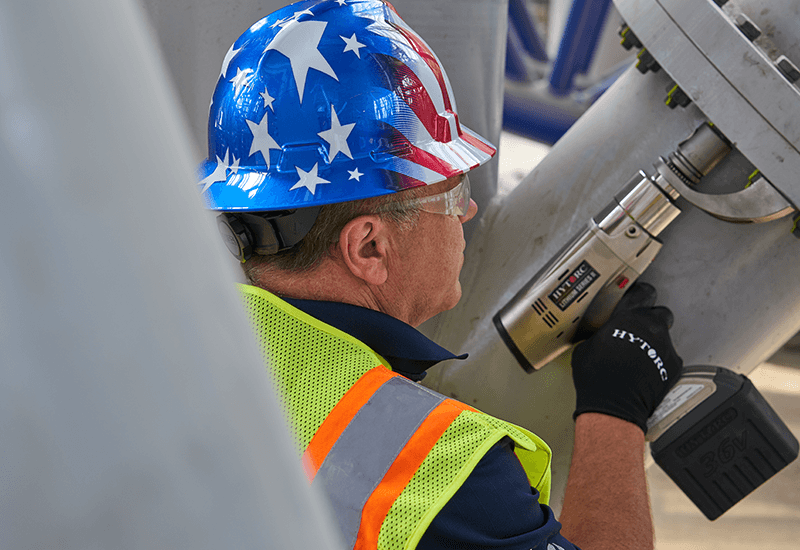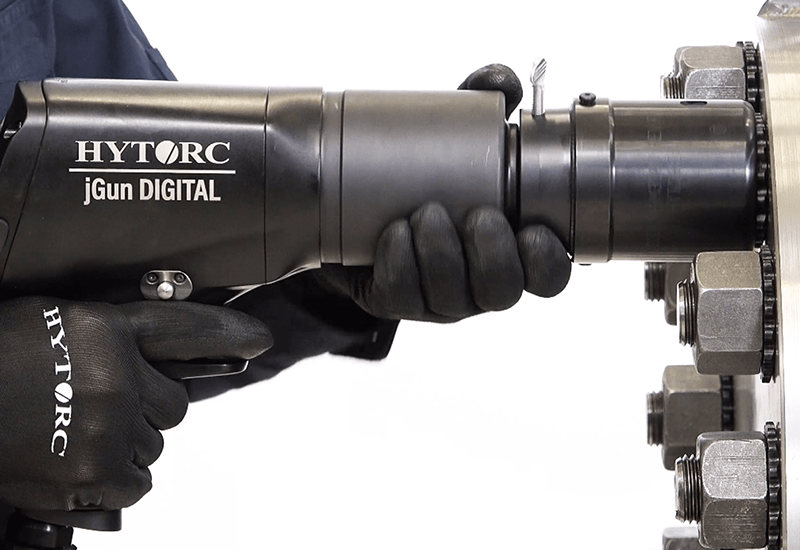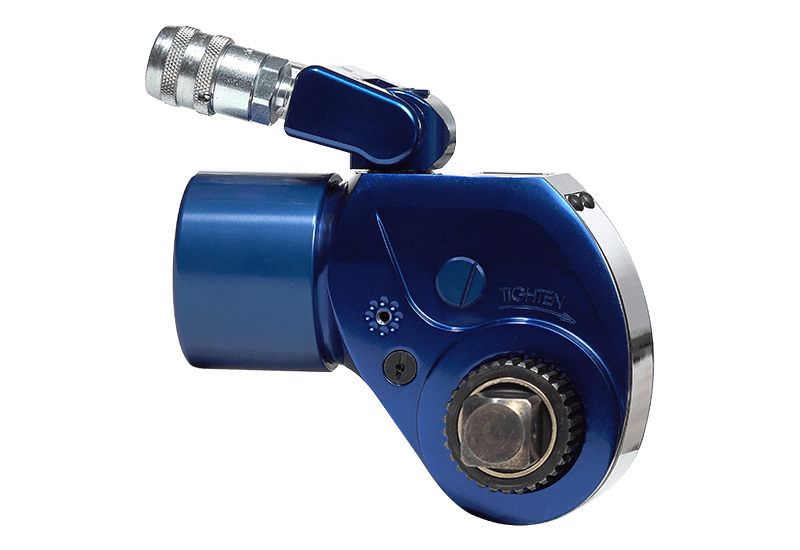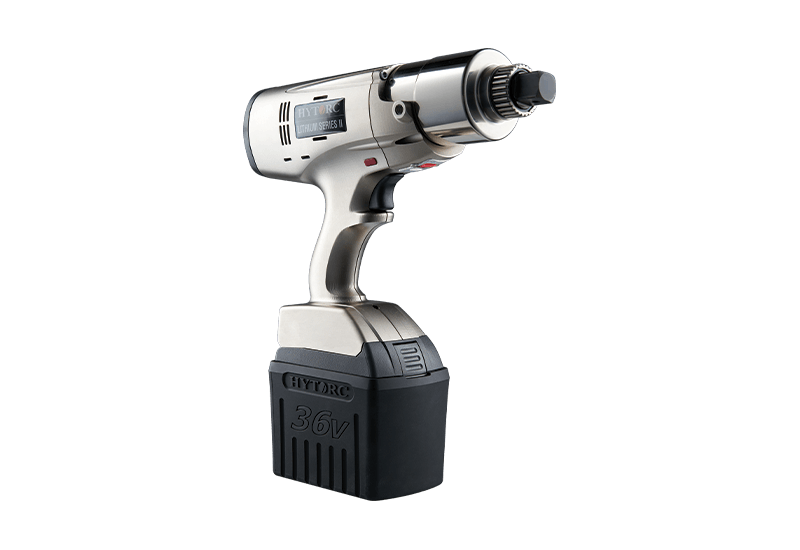

- Temporary or permanent pain and loss of use of hands or arms
- Muscle fatigue and weakness causes reduced mobility in the fingers, hand or arm.
- Damage to the blood vessels causes pain and discoloration.
- Damage to nerves causes numbness and tingling.
Risk and Responsibility
It is well established that exposure to high magnitude vibration power tools will increase the risk of a debilitating injury known as Hand-Arm Vibration Syndrome (HAVS). This injury causes damage to nerves, blood vessels, muscles, and joints
in the hands and arms. This injury may occur within a year or two of exposure or show up years later. Severe cases are irreversible and permanent. Employers across the world have a responsibility to be aware of the hazard and protect the workforce from this risk of injury.
Industry Standard
Government safety and health organizations have established the current standard Hand Arm Vibration (HAV) exposure limit (European Standard Directive 2002/44/EC) in a daily (8 hour) Exposure Action Value (EAV) of 2.5 m/s2• In Europe this is a law that must be followed by employers. Any tool with a declared vibration value greater enters a higher risk category and will require action on the part of the employer to limit the risk of injury. A worker who is exposed to vibration above a daily Exposure Limit Value (ELV) of 5 m/s2 is at high risk of developing HAVS.
Calculating The Risk Of Impact Wrenches
Employers conduct risk evaluation across a spectrum of scenarios by combining the tool vibration intensity with the exposure duration, where exposure is the actual "trigger-time" of an operator using the tool. Risk is calculated and categorized as low, moderate or high as shown in the diagram below. High vibration tools such as impact wrenches, if used frequently, quickly become a moderate or high-risk of HAVS injury. Most all impact wrenches exceed the industry standard Exposure Action Value (EAV) limit of 2.5 m/s2. Most impact wrenches also exceed the Exposure Limit Value (ELV) of 5 m/s2 meaning a high risk of developing HAVS. Reliable sources [1] of tool vibration data characterize impact wrench vibration at 7-to-11 m/s2 during typical job use.
[1] Sources of vibration magnitude data
Legend
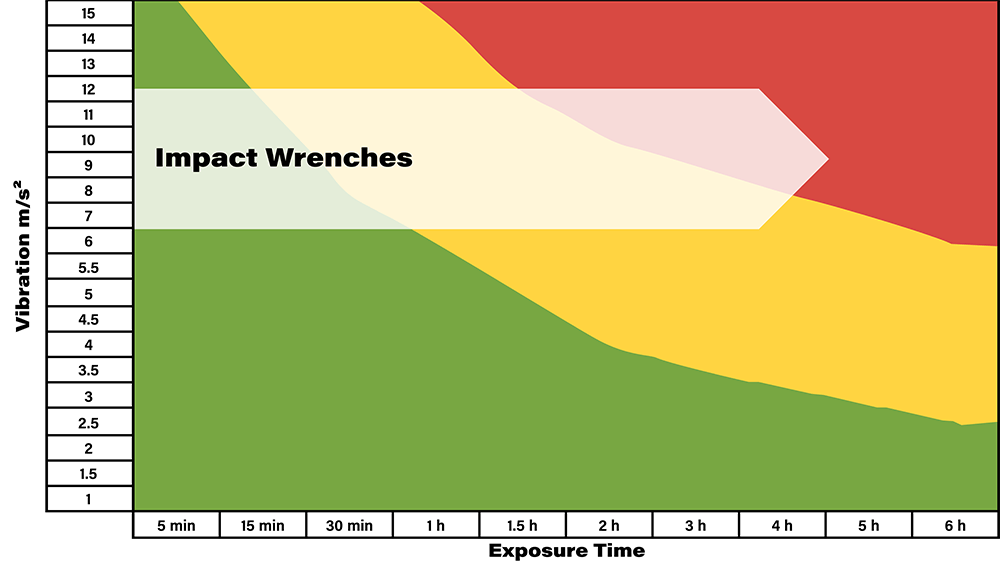
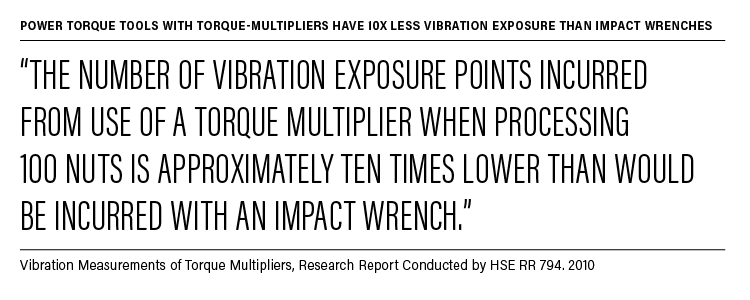
Administrative Controls
Exposure to vibration from moderate and high-risk tools like impact wrenches usually must be reduced through administrative controls. This may include rotating employees or limiting minutes of use. The National Institute of Occupational Health and Safety (NIOSH) recommends limiting the number of hours and days per week an employee must use a high vibrating hand tool. NIOSH suggests limiting its use to 10-minute operating cycles, totaling no more than two hours per day and no more than two consecutive days a week. Administrative controls also include monitoring the condition of the tool and the health of the workers. Many operators are discovering that administrative controls are difficult to manage, slowing jobs and still putting workers at risk.
Select Power Torque Tools With Torque-Multipliers
When planning repetitive bolting operations, low-vibration power torque tools with torque multipliers such as HYTORC Electric and Pneumatic Torque Tools are recommended to minimize risk. All of these tools have vibration exposure that is ten times less than impact bolting tools. These tools are certified with declared vibration less than the Exposure Action Value (EAV) of 2.5 m/s2• As shown in the diagram below Torque tools such as the HYTORC Electric and Pneumatic Tools have measured vibration values less than 1.5 m/s2. These tools can be used by an operator on a bolting job for an entire day while remaining in the "low risk" category and without concern of HAV injury.
Legend


What about anti-vibration gloves?
A NIOSH study found some Anti-Vibration Gloves (AV Gs) can reduce the intensity of vibration to the hand. Effectiveness is "highly dependent" on the tool vibration frequency and the amount of exposure. NIOSH concluded that AVGs cannot be relied upon alone to provide sufficient protection against HAV injury. Despite limitations that AVGs offer, gloves are still recommended PPE when using high vibration tools to keep hands warm and dry and to protect against cuts, abrasions and job hazards.

 English (United States)
English (United States)  English (India)
English (India)  Deutsch (Deutschland)
Deutsch (Deutschland)  简体中文(中国)
简体中文(中国)  Español (España)
Español (España)  English (South Africa)
English (South Africa)  English (Singapore)
English (Singapore)  Français (France)
Français (France)  English (Australia)
English (Australia)  English (United Kingdom)
English (United Kingdom) 